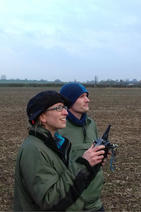22 Oct 2018
The science team’s summer of flying ended in September with approximately 10.5km² of surveyed moorland under our belt. Data has been collected from our field labs, which are specially identified areas that have received conservation works, or have certain characteristics such as being dominated by purple moor grass.

Monitoring at these field laboratories involves traditional survey methods including vegetation, water flow, water table and peat accumulation/erosion monitoring. In March 2019, treatments including sphagnum planting and gully blocking will take place. All this work is being carried out as part of the MoorLIFE2020 project.
Each field lab is approximately one hectare in size, but the UAV can fly up to 50 hectares in one flight so our scientists have been able to survey the 50 hectares surrounding each lab. Each lab has been ‘flown’ three times to collect three different types of images: high resolution images, multi-spectral images (where different vegetation types appear as certain colours on a computer when viewed in the different spectral bands) , and thermal images which we may be able to decipher surface wetness from, indicating the water level on the moors.
The photos have to be stitched together and geo-referenced with special software, so that we know exactly which photo is which bit of moorland. This is helped by the fact that our GPS is accurate to 2cm! The photos will then be sent to Nottingham Trent University for a comprehensive data analysis. Because this is the first year of flying, baseline data will be collected and used as the starting point to compare any changes in the vegetation cover.
Over the coming winter, the field labs will receive differing types and densities of sphagnum planting. In an innovative experiment, 11 different species of sphagnum will be planted in certain areas. The species and locations of these sphagnum samples will provide training data for the computer software. It is hoped that when the UAV flies next summer, it will be able to tell which species of sphagnum it is looking at!